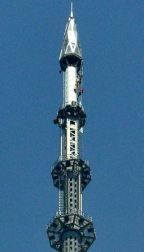NEW YORK—The Durst Organization has begun installing the first of several UHF antennas atop the spire of One World Trade Center as plans to move transmission facilities from the nearby Empire State Building—home to New York-area TV broadcasters since 9/11—get underway.

The first UHF panel, part of a 40-foot RFS antenna is being installed at One World Trade Center
The first panels of a 40-foot RFS PEP-40 UHF antenna are currently being installed at approximately 40 feet below the tip of the One WTC spire, which stands at 1,776 feet above lower Manhattan. That antenna will be joined by an RFS 662-16D CP VHF antenna immediately below, along with another UHF, the RFS PEP-96 antenna below that. The first broadcasters to use the antennas will be CBS, WNBC, Telemundo’s WNJU and PBS, according to John Lyons, director of broadcast communication for Durst, which co-developed 1 WTC with the Port Authority of New York and New Jersey, who added that transmission facilities should be ready in time for full operations by next May.
“We’re still building the transmission line from the antennas down. Putting the combiner system in,” Lyons said. “Stations have to build their transmission facilities.”
When the antennas will be fully installed will depend mainly on the weather. The installation is being done by a composite crew of Hatzel & Bueler Electrical Co. and Skyline Tower.
When the new transmitters are switched on, viewers will notice improved reception but the range will most likely not be extended much beyond what it currently is now, according to Lyons.
“The way the rules are written, the higher you go, you have to lower your power to compensate for it, so you stay on the same curve,” he said. “So I expect the distance to maybe be a little bit further but probably comparable to what’s out there now.”
The professional video industry's #1 source for news, trends and product and tech information. Sign up below.
Lyons noted the unique nature of the project, with the challenge of installing new antennas on the tallest building in the Western Hemisphere. “We were starting from zero actually, building the broadcast floor, putting in an emergency generating plant, and it was just starting from scratch with a spire that was designed to be an architectural spire regardless of whether there was going to be antennas on it or not.”
Tom has covered the broadcast technology market for the past 25 years, including three years handling member communications for the National Association of Broadcasters followed by a year as editor of Video Technology News and DTV Business executive newsletters for Phillips Publishing. In 1999 he launched digitalbroadcasting.com for internet B2B portal Verticalnet. He is also a charter member of the CTA's Academy of Digital TV Pioneers. Since 2001, he has been editor-in-chief of TV Tech (www.tvtech.com), the leading source of news and information on broadcast and related media technology and is a frequent contributor and moderator to the brand’s Tech Leadership events.

